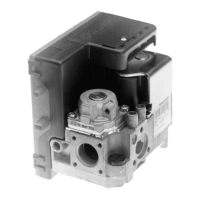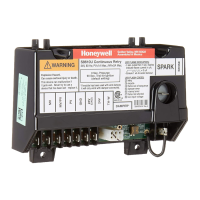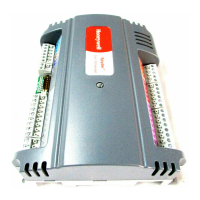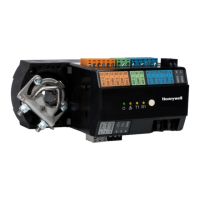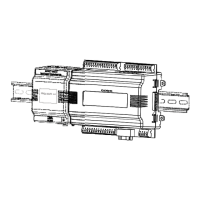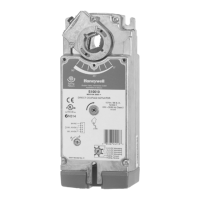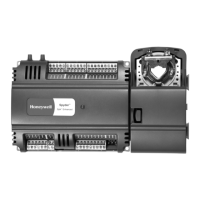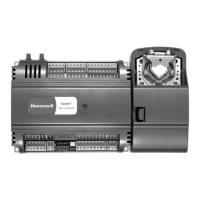SV9510/SV9520 SMARTVALVE™ SYSTEM CONTROLS
11 69-2014
SERVICE
WARNING
Fire or Explosion Hazard.
Can cause severe injury, death or property
damage.
Do not disassemble the ignition system control; it
contains no replaceable components. Attempted
disassembly or repair can damage the ignition
system control.
CAUTION
Equipment Damage Hazard.
Improper wiring can damage the equipment.
1. Do not apply a jumper across or short the
thermostat, 24V hot or 24V common terminal in
the SV9510/SV9520 wiring harness. Doing so
can burn out the heat anticipator in the
thermostat or damage the system transformer.
2. After servicing, verify proper system operation.
IMPORTANT
Allow 60 seconds after shutdown before
re-energizing step-opening model to assure
lightoff at step pressure.
Sequence of Operation
1. Make sure the ignition system control switch is in
the ON position.
2. Follow the sequence of operation as shown in Fig.
11.
TROUBLESHOOTING
Troubleshooting with LED Indicator Assistance
(No cycling of appliance power or thermostat call
for heat since appliance failure has occurred)
WARNING
Electrical Shock Hazard.
Can cause severe injury, death or property
damage.
Only a trained, experienced service technician
should perform this troubleshooting.
1. Check the system thermostat to make sure it is in
an active call for heat mode. (Do not cycle the ther-
mostat on and off at this time.)
2. Remove the appliance burner compartment door.
Do not interrupt the power to the SV9510/SV9520
by opening any electrically interlocked panels.
3. Observe LED indicator on SV9510/SV9520, check
and repair the system as noted in Table 9.
4. After LED flash code analysis and appliance repair
are complete, turn thermostat below room
temperature for 10 seconds; turn the thermostat
above room temperature to initiate a new call for
heat.
5. Observe the ignition sequence; comparing it to the
Sequence of Operation shown in Fig. 11. Allow the
new ignition sequence to proceed until appliance
lights or an abnormal or unexpected event is
observed. See next section.
Troubleshooting Without LED Indicator
Assistance (Appliance power or thermostat call
for heat has cycled since appliance failure
occurred)
WARNING
Electrical Shock Hazard.
Can cause severe injury, death or property
damage.
Only a trained, experienced service technician
should perform this troubleshooting.
1. Make sure the appliance power is on and any
manually operated gas cock on the appliance is
open.
2. Remove the appliance burner compartment door.
Confirm that SV9510/SV9520 LED indicator is
flashing in a “bright - dim” sequence.
3. Make sure the ignition system control switch is in
the ON position.
4. Disconnect the system thermostat leadwires at the
ST9160 EFT or the 208907 Terminal Board.
5. Using alligator clips on a short jumper wire, jumper
the R and W terminals on the EFT or Terminal
Board.
6. Observe the appliance operation, comparing it to
the Sequence of Operation shown in Fig. 11. Allow
the ignition sequence to proceed until the appliance
lights or an abnormal or unexpected event is
observed.
7. Check the appliance as shown in Table 10.
INSTRUCTIONS TO THE
HOMEOWNER
WARNING
Fire or Explosion Hazard.
Can cause severe injury, death or property
damage.
Follow these warnings exactly:
1. IF YOU SMELL GAS:
• Turn off the gas supply at the appliance service
valve. On LP gas systems, turn off the gas
supply at the gas tank.
• Do not light any appliances in the house.
• Do not touch electrical switches or use the
phone.
• Leave the building and use a neighbor’s phone
to call your gas supplier.
• If you cannot reach your gas supplier, call the
fire department.
2. The ignition system control must be replaced in
event of any physical damage, tampering, bent
terminals, missing or broken parts, stripped
threads, or evidence of exposure to heat.
IMPORTANT
Follow the operating instructions provided by the
manufacturer of your heating appliance. The
information below describes a typical ignition
system control application, but the specific
controls used and the procedures outlined by the
manufacturer of your appliance can differ,
requiring special instructions.
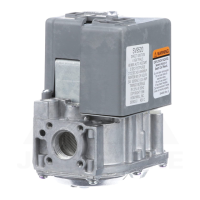
